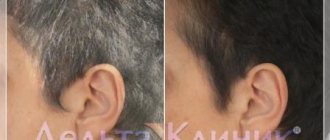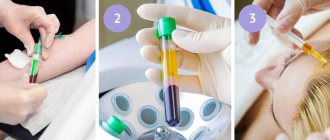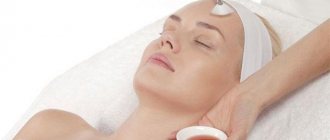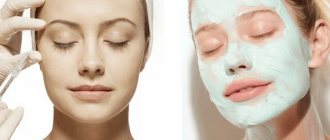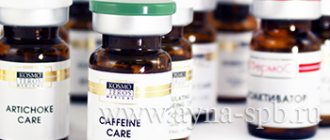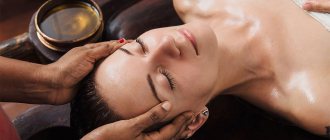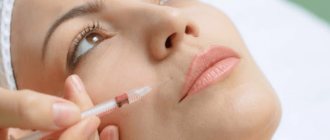Hair loss, fragility, dull and inexpressive color, dry scalp? Are you familiar with these aesthetic defects?
In this article we will talk about injection procedures: plasma therapy and mesotherapy, as hair care products.
These procedures have gained such popularity due to the large number of grateful clients.
Designation of the concept
Plasmolifting is the intradermal injection of the patient’s own plasma (the liquid part of centrifuged blood) saturated with platelets to stimulate cellular processes. This procedure is a variant of biomesotherapy, since the patient’s own materials are used for treatment. The name means “skin tightening with plasma,” where the latter is a valuable substance in our blood.
Mesotherapy is a method of “soft healing” of the skin through microinjections of medications. The procedure gets its name from the word “mesoderm” - the middle layer of skin with many blood vessels into which the active components of the “cocktails” penetrate.
Story
The founder of mesotherapy is the French doctor Michel Pistor, 1950.
Plasmolifting for cosmetology was discovered in 2003 by R.F. Zarudiy and R.R. Akhmerov - Russian maxillofacial surgeons. It was originally used in surgery to restore soft tissue.
Indications for mesotherapy
- Correction of facial oval.
- Skin irregularities.
- Having a “double chin”.
- Decreased elasticity and tone of the skin.
- "Grey" complexion.
- Prevention of premature aging.
- Oily skin.
- Pigment spots, enlarged pores.
- Prevention of vascular changes.
- Decreased skin moisture.
- Correction of hair loss, rosacea, rosacea as part of complex therapy.
- Reducing the appearance of cellulite and stretch marks.
Indications for plasma lifting
- Age-related changes (skin sagging, expression lines, elastosis, sagging epidermis).
- Deformations of the tissues of the face and neck.
- Skin texture disorders (scars, stretch marks, post-acne).
- Acne.
- Hyperpigmentation.
- Cuperosis.
- Photo-, chronoaging.
- Dry, oily, stressed skin.
- Diffuse alopecia, dandruff.
- Sunburn.
- Rehabilitation after invasive techniques (plastic surgery, installation of mesothreads) and peelings.
- Correction of age spots, stretch marks.
Contraindications
Mesotherapy and plasma lifting are reliable methods of skin restoration. But in order to avoid adverse consequences, there are certain contraindications.
- Pregnancy, lactation period.
- Inflammatory processes, pustular skin lesions in the affected area.
- Fever.
- Herpetic infection.
- Systemic blood diseases.
- Hypertension stage II-III.
- Epilepsy.
- Kidney, liver failure.
- Tendency to keloid scars.
- Tuberculosis.
- Severe chronic diseases.
- Malignant neoplasms.
- Autoimmune processes (scleroderma, systemic lupus erythematosus, rheumatoid arthritis).
Plasmolifting is not additionally performed for infectious diseases (hepatitis, HIV, AIDS, syphilis, viral processes), blood diseases, or the use of antiplatelet agents.
Patient reviews
On forums dedicated to injection medicine, there are many positive reviews about the use of cosmetic techniques. The main condition for the effectiveness of the procedure is the choice of a qualified specialist.
The user writes about the pronounced result as after grinding. I have repeatedly heard positive reviews from doctors about the plasma lifting procedure for rejuvenation and getting rid of acne. The result of scar smoothing is amazing.
The author points out the different effects of plasma therapy for different age groups, as well as for solving aesthetic problems.
The participant describes his experience with plasma lifting. Among the positive aspects, he notes the effect of transformation; the disadvantages include a short-term effect.
The user writes about repeated mesotherapy and good results from the procedure.
The author describes the experience of performing mesotherapy for age spots. The result after the course of procedures exceeded all expectations.
Techniques
- Linear intradermal - administration of the drug on the reverse stroke of the needle.
- “Nappage” is the introduction of minimal doses of a substance to the treatment area. The skin is slightly injured, but a large loss of the drug occurs.
- Papular - intradermal injection with the formation of microtubercles at a distance of 1.5 - 2 cm from each other.
- Deep injection - used to correct local fat deposits during mesotherapy.
The puncture depth is up to 3 mm for both methods.
Ingredient introduction methods
When plasmolifting, only the manual method of administration is used.
For mesotherapy, a mesoinjector (a special gun with needles) or a manual method (using a syringe) is used.
Characteristics of components
In mesotherapy, there are drugs with a wide spectrum of action to solve specific problems.
Differences in the type of active substances
- Allopathic - vitamins, minerals, oligoelements, lipolytics.
- Homeopathic - includes only plant substances.
Differences in the number of components
- Monopreparations - contain only one active component, for example, hyaluronic acid, artichoke extract, vitamin C.
- Individual “cocktails” are meant to be prepared independently by a doctor.
- Complex preparations - contain several biologically active substances to solve specific problems, for example, to reduce age spots, correct cellulite, treat seborrheic dermatitis.
Differences in mechanism of action
- Hyaluronic acid 0.3-1% - stimulates protein synthesis, provides natural skin hydration (KOSMO-DMAE KOSMOTEROS with hyaluronic acid 1.2%, 1% DMAE and red grape extract for express lifting and super-hydration).
- Artichoke extract - reduces the severity of cellulite and swelling (artichoke concentrate ARTICHOKE CARE KOSMOTEROS).
- Antibacterial agents - for inflammatory processes (acne).
- Vitamin C - brightens and rejuvenates the skin (meso-cocktail with vitamin C KOSMO-C KOSMOTEROS).
- B vitamins - regenerate the skin, strengthen hair follicles, stimulate renewal processes. The drugs are in liquid form.
In plasma lifting, the main active ingredient is its own biostimulating plasma of a gel structure. Platelet autoplasma is obtained by taking blood from the antecubital vein from a patient, followed by processing in a centrifuge (special apparatus). Centrifuged plasma is saturated with intercellular fluid and contains a large amount of vitamins, proteins, and immune complexes that stimulate cell restoration and hydration.
The price of manipulation depends on the choice of technique, resource consumption, skin condition, area of influence, dosage and number of sessions.
How many plasma therapy sessions are needed to see results?
Plasma therapy or PRP therapy, like many cosmetic procedures, is performed in courses. You will feel and see real changes in the condition of your hair after the first series of injections. But this does not mean that you can stop there. On average, a full course consists of 10 procedures. Their exact number will be determined by the doctor who will supervise your progress towards the desired goal - strong and healthy hair.
The plasma therapy service is available to all our clients living in Moscow and the Moscow region. Although the region of your residence is not decisive. We accept everyone. We would like to draw your attention to the fact that the Evolution clinic has a medical license. Cosmetologists with higher medical education will work with you. They have many years of successful experience in conducting PRP therapy procedures.
You will not spend a single ruble in vain. The price of plasma therapy for hair in our clinic is competitive and affordable, and the company’s pricing policy allows you to receive additional benefits. By taking advantage of bonuses, discounts and special offers, you will be pleased to discover that you spent less than you expected.
In order to determine indications for plasma therapy and receive qualified advice on the condition of your hair and solutions to related problems, make an appointment with a trichologist by phone: +7 (495) 126 49 68.
Treatment frequency
With mesotherapy, a cumulative effect is formed, which persists with an increase in the number of sessions, because hyaluronic acid in meso-cocktails is not able to integrate into the structural components of the skin. An acceptable course of procedures is 8-12 sessions with an interval of 1 time every 7-14 days. Maintenance procedures are carried out 1-2 times a month.
During plasma lifting, immune memory is formed due to the activation of growth factors located in the autoplasma, so the preferred course of procedures is 3-8 sessions with an interval of once every 2-4 weeks. The maintenance course is carried out 1-2 times a year.
Mesotherapy of the abdomen and body
"Orange peel" under the skin on the body or abdomen. Hips and abdomen are problem areas for most women. After sudden weight loss and childbirth, the skin in these places becomes flabby and sagging. Physical activity is not always able to improve the situation. Many people decide on such radical methods as liposuction or abdominoplasty. But it is worth noting that these are surgical interventions and are prescribed only for sufficiently large volumes in the waist and hips. If you need to get rid of a few centimeters, it is better to do mesotherapy.
Sometimes mesotherapy is used together with liposuction. A course of procedures is carried out both before and after the operation, which allows you to enhance the effect several times and make the skin elastic.
Stages of implementation
Injection procedures are carried out in compliance with the rules of asepsis and antiseptics, and are divided into stages.
- Preparatory - carried out during plasma lifting. Blood tests are taken (general, biochemical, for markers of infectious diseases) and recommendations are given (light meal the night before, blood sampling on an empty stomach).
- Cleansing and disinfection - treating the skin with an antiseptic to prevent infection.
- Anesthesia - a local anesthetic is applied under the film for 20-30 minutes.
- Preparation of ingredients - ready-made solutions are used or substances are independently selected for mesotherapy. During plasma lifting, at each session, blood is taken from the ulnar vein in an amount of 10 to 40 ml (depending on the purpose of the appointment) while maintaining sterility. A test tube with biological fluid is placed in a one-stage centrifuge (a device that separates blood into fractions at high speeds within a few minutes). The platelet part is released with a pronounced effect. After this, the plasma concentrate is ready for subsequent manipulation.
- Introduction of components - exposure to the necessary technology.
- Post-procedure treatment - a cream with protective and restorative properties is applied.
- The purpose of home care is products for cleansing, nutrition, moisturizing, protection.
The influence of patient age on the effectiveness of sessions
Mesotherapy activates the skin with vitamins and minerals at the cellular level, so procedures are recommended for people over 18 years of age (for example, for acne, products containing silicon, zinc, selenium, and B vitamins are used). From 30-40 years old, peptide products with a stimulating effect on the skin are selected.
Plasmolifting activates the internal reserves of the skin, therefore, procedures are carried out from 25 years of age. From the age of 20, manipulation is carried out when the condition of the skin of the scalp is disturbed.
Hair jewelry increases breakage and hair loss
The function of hairpins, headbands, and hair ties is more aesthetic than practical. Thanks to them, you can create almost any, even the most complex, hairstyle. However, with constant use, creases appear in the places where accessories are attached. In the future, this will lead to thinning of the hair, damage to its structure, and increase fragility and intensity of hair loss.
The solution in such a case would be to limit the use of hair jewelry. If you need to hide your curls, use a decorative net or cosmetics that provide hair fixation.
Side effects
Hyperemia (redness) is a natural consequence of increased blood circulation.
Pain - the degree of painful reaction depends on the individual threshold of pain sensitivity, the state of the nervous system, the drugs administered and the injection technique used. In case of increased sensitivity, apply a cream with an anesthetic 20-30 minutes before the procedure.
Hematomas occur when the integrity of the vascular wall is disrupted.
Allergic reactions are a response mechanism to drug components. Preliminary research and selection of ingredients is important. With plasma lifting, allergies practically do not occur, since plasma is an autograft, a natural physiological component.
What is better to choose
The choice of procedure should be entrusted to a professional. The cosmetologist, after assessing the condition of the integument, medical history and tests, will suggest the most optimal option for the patient. Plasmolifting does not cause an allergic reaction and has a cumulative effect. If you need to quickly achieve a transformation effect, beauty injections with their multi-component compositions are considered the best.
For many, the deciding factor is the price; the cost of plasma lifting, due to the use of special technology, is 2 times higher than mesoinjections. Plasmolifting has an impressive list of contraindications; when choosing mesotherapy, you can use alternative methods - non-injection, fractional.
What is better for the face: mesotherapy or plasma lifting?
Both procedures have a beneficial effect on skin cells and tissues. Depending on the questions asked, a specific type of manipulation is selected.
To enrich the skin with a vitamin-mineral complex and have enough time, it is better to choose mesotherapy. It stimulates cellular restoration processes and solves certain problems, since the composition of the drugs is dominated by active components with a localized spectrum of action.
For long-term correction of age-related changes and activation of cellular renewal processes, as well as stimulation of local immunity, plasma lifting should be chosen. The procedure awakens the resource potential of the skin thanks to a natural physiological component - its own plasma.
Comparison table of both methods, their pros and cons
To begin with, let us outline the main advantages and disadvantages of the methods:
| Procedure name | pros | Minuses |
| Mesotherapy | + Ability to select a drug depending on the nature of the problem; + possibility of performing injection and non-injection procedures; + the result is noticeable 1-2 days after the procedure. | — There is a possibility of side effects; - short-term result; - high cost of treatment. |
| Plasmolifting | + Use of autografts that are absolutely safe for the patient’s health; + long lasting effect. | — High cost of a course of therapy; - exclusively injection administration of the drug; — first results – 8-12 days after the first session. |
What is better for hair treatment: mesotherapy or plasma lifting?
Mesotherapy and plasma lifting have similar points of influence for treating the scalp, but have different degrees of influence.
Range of applications
- Hair loss, slower hair growth.
- Seborrhea, dandruff.
- Baldness (alopecia).
- Increased oiliness, dryness, itching of the scalp.
- Thinning of the hair shaft (hair fragility).
- Hair damage due to perming, coloring, and ultraviolet exposure.
When using meso-cocktails (for example, Dermahil HL containing peptides, amino acids and vitamins), the condition of the scalp is normalized (nutrition of hair follicles, activity of the sebaceous glands, blood microcirculation).
The plasmolifting technique is a kind of hair growth activator. Autoplasma enhances cellular metabolism and skin immunity, effectively reduces serious inflammation of the follicular apparatus.
Mesotherapy – description of the technique, effect, contraindications
Mesotherapy is a minimally invasive cosmetic procedure that involves the introduction of biologically active substances under the skin using injections or other methods. The technique of subcutaneous administration of drugs to solve certain aesthetic problems was invented in the mid-19th century in France. The term “mesotherapy” comes from the word “mesoderm”, which is the middle layer of the skin where the blood vessels are located.
Mesotherapy preparations may contain vitamins, proteins, enzymes, plant extracts, hyaluronic acid, collagen and other biologically active components.
The purpose of mesotherapy depends on the location of the injections - restoring the beauty and youth of the skin, removing excess fat, normalizing hair growth and preventing baldness, preventing age-related changes in the skin and inhibiting the aging process.
Mesotherapy application areas:
- Face, including eyelids and area around the eyes.
- The scalp.
- Chin and neck.
- Neckline area.
- Hips, buttocks.
- Stomach.
- Arms and legs.
- Back.
The effectiveness of mesotherapy is based on the fact that during the procedure, biologically active components enter the deep layers of the skin. It is impossible to achieve such a result using external means, since the effect of substances that are not able to penetrate deep into the epidermis is weakly expressed.
The effectiveness of mesotherapy for the skin of the face, neck, and décolleté depends on the composition of the drug that is injected into the epidermis. Experts say that after the procedure you can get the following result:
- Hyaluronic acid helps improve skin moisture. It stimulates metabolic and regenerative processes, due to which the condition of the epidermis improves. Wrinkles disappear, skin becomes lighter.
- Collagen helps smooth out facial wrinkles and age-related wrinkles, makes the skin firm and elastic, improves the texture of the skin and the oval of the face even in adulthood.
- Vitamins, vitamin cocktails, microelements and other dietary supplements make the skin fresh, radiant, as well as soft and velvety. The drugs improve skin tone and eliminate spider veins.
- Whitening acids help eliminate freckles and age spots.
In general, mesotherapy helps stimulate the production of your own collagen, accelerate blood flow, cell division and renewal, improve oxygen saturation and tissue trophism, and accelerate lymph outflow.
In cosmetology, the following products are often used for mesotherapy:
- DMAE is a drug that has a lifting effect. If the patient has severe bags under the eyes, 1% DMAE can be applied to the lower eyelids.
- GLUTA (600, 1200) is a drug that is used to eliminate age-related pigmentation of the skin. Has a pronounced whitening effect.
- Vitamin C - injections of this product are made to obtain a whitening effect and treat acne.
The number of mesotherapy sessions is selected individually. The physiological characteristics of the client, the nature of the problem and its severity are taken into account. On average, from 4 to 10 sessions are carried out at intervals of 5-7 days. But positive changes and the expected result can be noticed after the first procedure. After completing a course of mesotherapy, you can carry out preventive procedures once every 6 months for women over 30 years old, once every 12 months for women aged 18-30 years.
Before mesotherapy using a drug new to the patient, it is necessary to do an allergy test for the composition of the injection. To do this, a shallow injection is made on the client's forearm and the skin's reaction to the applied drug is assessed. If characteristic allergy symptoms (itching, swelling, redness, urticaria) do not occur, then the patient can undergo mesotherapy using these injections.
Indications for mesotherapy of the face and body:
- Expression and age wrinkles in women and men in any area of the face.
- Changing the oval of the face, shaved hair, double chin.
- Loose skin on the neck.
- Bags or bruises under the eyes.
- Swelling of the face.
- Deep nasolabial folds.
- Drooping of the corners of the eyes or lips.
- Age-related pigmentation.
- Dehydration of the skin, flaking.
- Dull skin, unhealthy complexion.
- Drooping or, conversely, sunken eyelids.
- Redness and irritation of the skin.
- Skin irregularities, scars, cicatrices, acne.
- Enlarged pores, disruption of the sebaceous glands, comedones, blackheads.
- The consequences of pregnancy and childbirth or sudden weight loss are stretch marks and pigmentation of the skin.
- Spider veins on the skin, redness, rashes.
- Cellulite on thighs, buttocks.
- Skin diseases, rashes on the body.
If a patient is diagnosed with defects in the surface relief of the skin, he may be offered fractional hardware mesotherapy. This is a method that involves microinjections. The specialist goes over the problem area with the finest needles. More than 800 micropunctures are made in one minute. The drug that is administered starts the recovery processes. The body, for its part, also reacts to such intervention - cell migration begins to the damaged area. As a result, the skin texture is evened out and it becomes smooth.
Mesotherapy is also used to improve the condition of scalp hair. After several procedures, the structure of the scalp, the activity of the sebaceous glands, and blood microcirculation are normalized. Hair begins to grow faster, becomes strong, shiny, thick, and better tolerates the effects of negative external factors.
Indications for scalp mesotherapy:
- Disturbance, slowing of hair growth.
- Itchy scalp.
- Dandruff.
- Hair loss, baldness in men and women.
- Early gray hair.
- Brittleness, dryness, increased oiliness of hair, split ends.
- Thin, insufficiently pigmented hair, insufficient hair volume.
Mesotherapy is also used to shorten the recovery period after plastic surgery, contouring or other cosmetic procedures.
There are also contraindications for mesotherapy:
- Pregnancy and lactation period.
- Pathological fear of needles (for injection mesotherapy).
- Infectious and inflammatory processes in the body.
- Severe chronic diseases in the acute stage.
- Neurological or psychological diseases.
- Systemic pathologies, autoimmune disorders.
- Individual sensitivity to the components of the injection composition.
- Tendency to form scars.
- Blood diseases that are accompanied by a violation of blood clotting.
- Oncological diseases.
- Neoplasms at injection sites.
- Diseases of the cardiovascular system.
- Kidney or liver failure.
- Possible side effects after the mesotherapy procedure:
- Bruising or redness of the skin at the injection site.
- Swelling of the skin.
- Penetration of infection, foci of inflammation.
To reduce the likelihood of complications, you need to carefully choose the clinic and specialist who will perform the procedure. The main causes of complications are incorrect selection of drugs, violation of the technique of administering drugs and the rules of asepsis and antisepsis, low qualifications of the specialist performing the procedure.
To avoid complications, you also need to properly prepare for mesotherapy and follow the cosmetologist’s recommendations during the rehabilitation period. Two weeks before the procedure, you need to refuse any cosmetic sessions. A day before mesotherapy, you need to stop using decorative cosmetics. After visiting a cosmetologist, you need to reduce the load on the body for a couple of days - do not drink alcohol, do not engage in active sports. It is also not recommended to sunbathe in the sun, visit a solarium, a bathhouse, or a public swimming pool. If bruises appear at the injection site (a predicted side effect), you should not use foundation to disguise them, as it can cause infection. The cosmetologist will recommend a medicinal ointment, and the bruises will disappear in a few days.
In modern cosmetology, not only injection mesotherapy is used; there are other methods that are no less effective. For example, mesotherapy using a laser or electromagnetic device. How this procedure is carried out:
- The patient's skin is cleansed of dirt and sebum and disinfected.
- A meso cocktail is applied to the skin.
- Delivery of the drug to the deep layers of the epidermis is carried out using laser or electromagnetic influence.
- The advantages of non-injection mesotherapy are obvious - you do not need to endure injections, after the procedure there is no swelling or side effects in the form of bruises.
- Mesotherapy can be carried out in combination with other cosmetic procedures:
Peeling, and after 10-15 days mesotherapy. After peeling, the intensity of metabolic processes and the ability of skin cells to regenerate increase. 2 weeks after peeling, the skin is completely ready for mesotherapy. The sequential use of these cosmetic procedures has a pronounced synergistic effect.
Mesotherapy, and after 15 days injections of Botox or similar drugs. Injections of solutions used during mesotherapy help enhance regenerative processes in skin cells and accelerate the restoration of facial activity. Therefore, Botox is administered after, and not before, mesotherapy cocktails.
Advantages
- Painless procedure. Non-injection mesotherapy does not cause any discomfort. And if injections are given, the cosmetologist can numb the treated area with a local anesthetic.
- Precise, local action exactly in the area that needs correction.
- Large selection of drugs to solve a wide range of aesthetic problems
- problems. The ability to combine mesotherapy with other types of cosmetic procedures.
- With the right approach to choosing a clinic, the likelihood of negative consequences occurring is extremely low.
- There are no restrictions on the patient's age. Mesotherapy can be done even for teenagers to treat acne (with parental consent).
Flaws
- High cost of procedures. In Moscow, one mesotherapy session will cost an average of 5,000 rubles, in other regions - from 3,000 to 4,500 rubles.
- The result is temporary, the procedure must be repeated constantly to maintain the effect.
Conclusion – who is suitable for mesotherapy?
Mesotherapy is an excellent method of restoring the structure and aesthetic characteristics of the skin and other tissues. This type of injection therapy is suitable for those who have the appropriate financial resources and there are no medical contraindications.
Alternative techniques
If contraindications to the procedure and fear of pain are identified, hardware mesotherapy methods are used that do not injure the skin, do not cause swelling and do not require a recovery period.
- Phonophoresis is the penetration of substances using ultrasound.
- Ionomesotherapy is the administration of drugs using galvanic current. The procedure is affordable, but the size of the electrodes limits the area of impact.
- Electroporation (aquaphoresis) is the delivery of active components using low-frequency electrical pulses, which open aquaporin channels on the skin and increase the permeability of cell membranes.
- Cryomesotherapy - therapeutic components penetrate the skin under the influence of current and low temperature.
- Laser therapy - a focused beam of light stimulates microcirculation and enhances the penetration of substances.
An alternative method of plasma lifting is considered to be laser exposure - the procedure is comfortable, painless due to the narrowly focused action of the light beam, but ineffective.
Opinion of cosmetologists
Cosmetologists actively discuss the features of procedures, effectiveness, and possible disadvantages.
A forum participant describes the features of plasma lifting, the need for quick introduction and completion of the course to achieve lasting results of rejuvenation. The disadvantages of the procedure include its high cost.
The author writes that he is satisfied with the effect of plasma lifting to eliminate the rings of Venus.
The cosmetologist asks his colleagues about the attitude of immunologists to plasma therapy; if proteins are damaged, autoimmune reactions can occur.
The master advises his colleague to use Angioftem from Mesoarm to solve the problem of rosacea.
